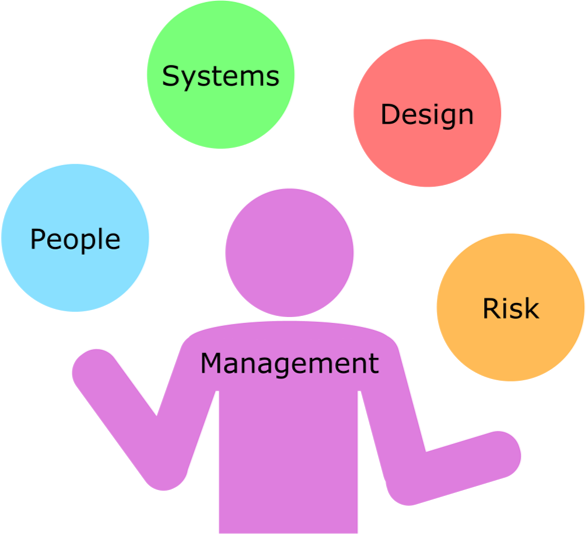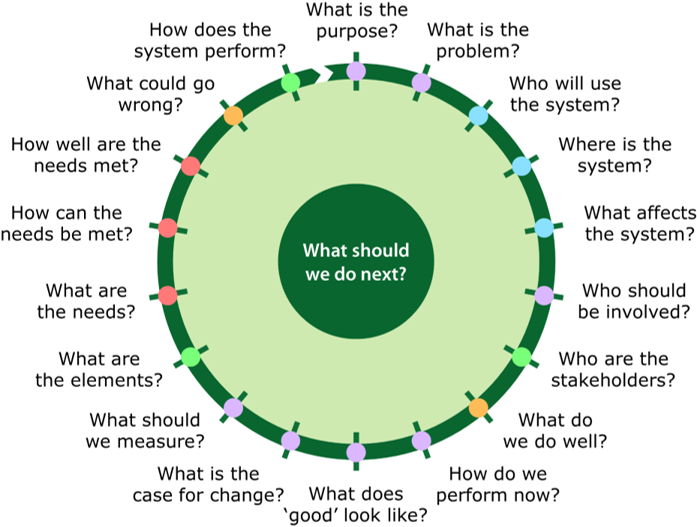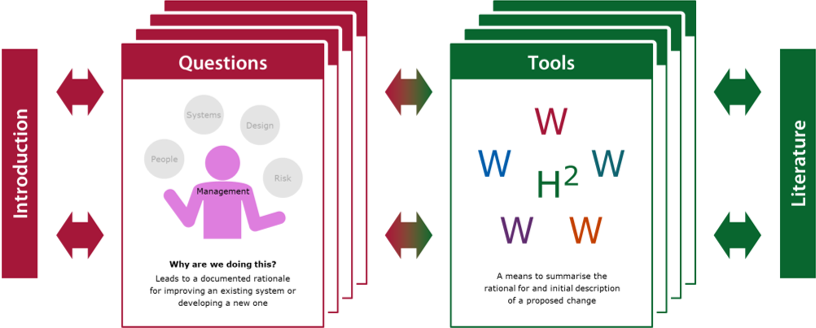This introduction describes a set of questions that form the basis of a systems approach to health and care design and continuous improvement.
The engineered world is full of systems. From the simple water heater to the fully integrated international airport, from ancient irrigation systems to modern communication networks, all systems share one key feature: their elements together produce results not obtainable by the same elements alone. These elements, or parts, can include people, processes, information, organisations and services, as well as software, hardware and other systems.
A system (or system of systems) is a set of elements: people, processes, information, organisations and services, as well as software, hardware and other systems that, when combined, have qualities that are not present in any of the elements themselves. A system is delineated by its spatial and temporal boundaries, surrounded and influenced by its environment, described by its structure and purpose, and expressed in its functioning. In other words, the whole is very likely to be greater than the sum of the parts. The layout of the system, defining all the elements and their interconnections, needs to be carefully considered to ensure that each element on its own and in combination with others performs as required. In response to this challenge and the ever increasing complexity of modern systems, a new discipline of systems engineering has evolved as an interdisciplinary approach to enable the realisation of successful systems.
“Systems that work do not just happen —
they have to be planned, designed and built ”
Engineers routinely use a systems approach to address challenging problems in complex projects. This allows them to work through the implications of each change or decision they make for the project as a whole. They consider the layout of the system, defining all the elements and interconnections, to ensure that the whole system performs as required. One example is the successful delivery of the London 2012 Olympic and Paralympic Games. Physical infrastructure and practical organisation were brought together, with innovative physical engineering, modelling and simulation of people flows, early testing of venues, and extensive risk management. A systems approach, combined with tried and tested engineering methods and tools, delivered real success on a massive scale.
As already seen in the Improving Improvement section of this toolkit, the Engineering Better Care report describes the development of a systems approach to health and care design and continuous improvement, taking inspiration from both the healthcare and engineering sectors. It takes a broad view of systems (or systems of systems) as a set of elements that include people, processes, information, organisations and services, as well as software, hardware and other systems that, when combined, have qualities that are not present in any of the elements themselves. It then proposes that a systems approach is a process that integrates four key and complementary perspectives:
- People: understanding of interactions among people, at the personal, group and organisational levels, and other elements of a system in order to improve overall system performance
- Systems: addressing complex and uncertain real world problems, involving highly interconnected technical and social elements that typically produce emergent properties and behaviour
- Design: focusing on improvement by identifying the right problem to solve, creating a range of possible solutions and refining the best of these to deliver appropriate outcomes
- Risk: managing risk, based on the timely identification of threats and opportunities in the system, assessment of their associated risks and management of necessary change.
Each of the four perspectives of people, systems, design and risk can be seen as individual components within an overall improvement process. However, while each uniquely contributes to a systems approach, they are inextricably linked and the challenge is to integrate them within a useful, versatile and systematic process that repeatedly delivers results. The Engineering Better Care report presents the improvement process as an ordered set of questions, based on the individual perspectives, that should be asked until the current system is improved to delivered something measurably better into service. That sequence of questions has been extended to introduce questions related to the management of the improvement process.
The following sections describe the contents of this toolkit relating to the people, systems, design, risk and management perspectives associated with improvement process. In each case, a brief introduction to the perspective is provided, along with details of the questions related to that perspective and tools that may be used to help answer those questions. An introduction to the literature related to each perspective is also provided.
Reference is made throughout to the contents of the Improvement Resources section of this toolkit and to the cards, posters and worksheets included in the toolkit. The methotrexate and Esther case studies described in the Improving Improvement section of this toolkit are also reintroduced and extended to provide insight as to how the questions might have been answered in these studies.
Feedback
We would welcome your feedback on this page:
Privacy policy. If your feedback comments warrant follow-up communication, we will send you an email using the details you have provided. Feedback comments are anonymized and then stored on our file server
Read more about how we use your personal data. Any e-mails that are sent or received are stored on our mail server for up to 24 months.




